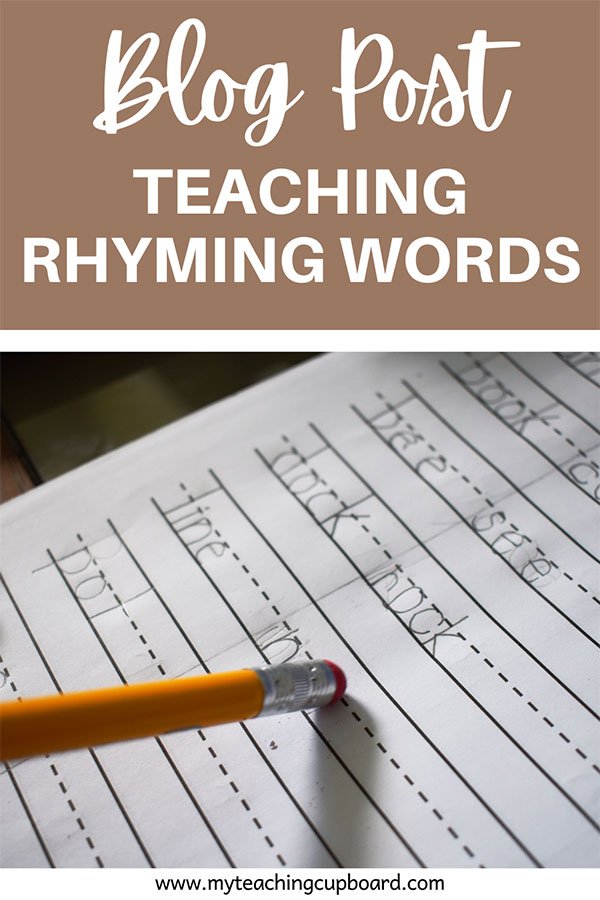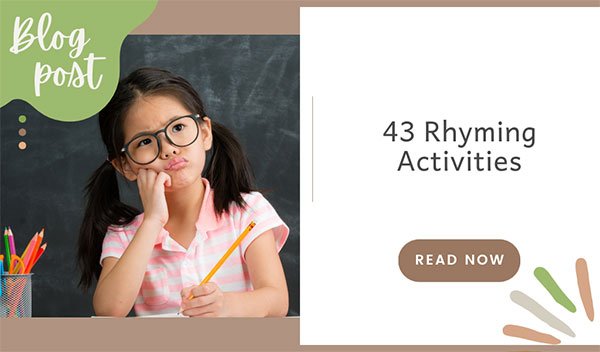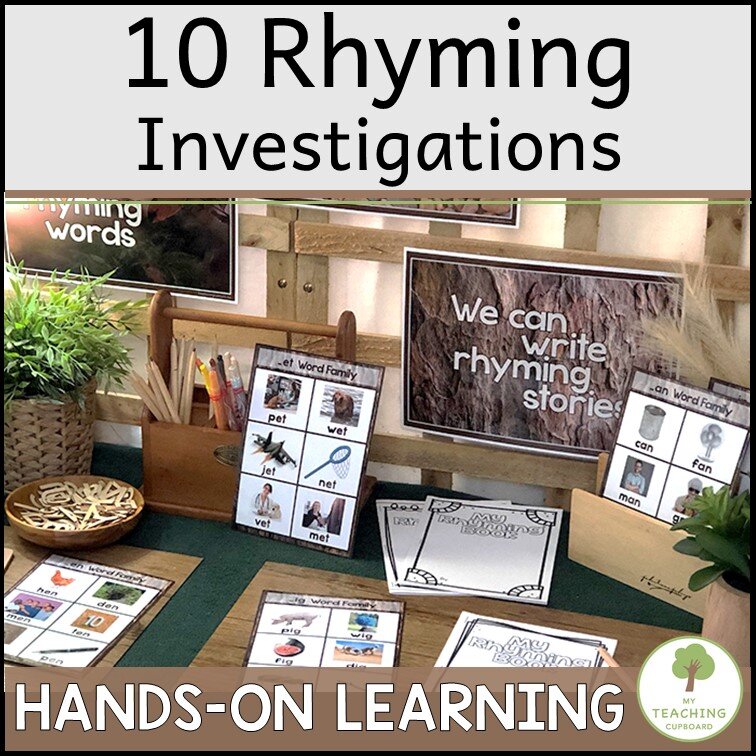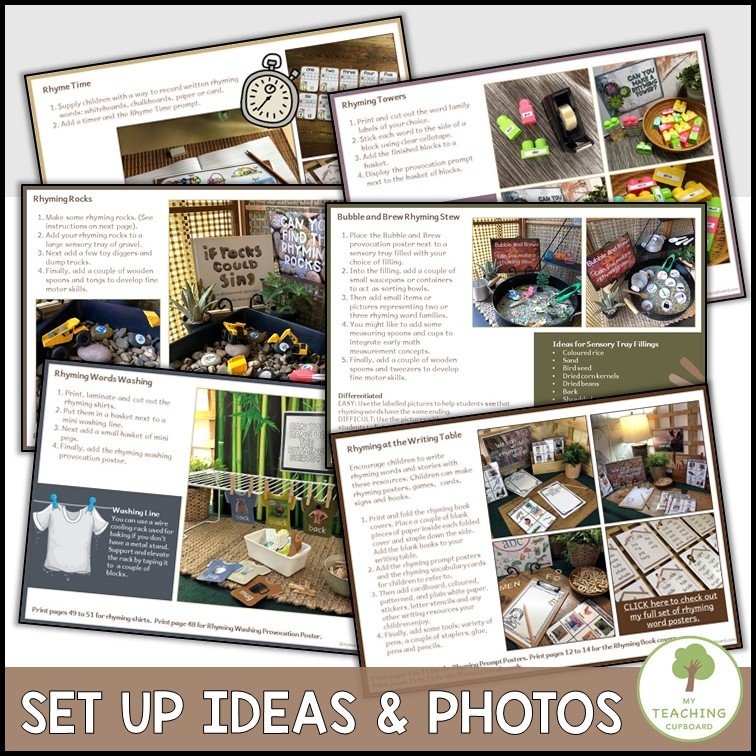Teaching Rhyming Words
All early childhood teachers need to be competent at teaching rhyming words. Rhyme is an important concept in preschool and kindergarten because the ability to recognise, combine and manipulate the sounds in words are important pre-reading and pre-writing skills. These skills should be taught in every early years literacy program.
If you are wondering why you need to be teaching rhyme or how to effectively teach the skill of rhyming to your students, this blog post is for you.
Rhyming words are words that have the same ending sound. The emphasis is on the sound and not the spelling. That’s why identifying and producing rhyming words are phonological awareness skills.
Why Learn Rhyming Words?
From preschool and kindergarten right through to grade one and two, lessons on rhyming words are beneficial and necessary in developing early reading and writing skills.
Research indicates a direct correlation between learning rhyming and eventual reading readiness. There are many benefits of teaching rhyming words:
rhyming helps children improve their oral language skills
it lays the groundwork for spelling and written language
rhyming develops predicting skills – a reading comprehension strategy
it is fun!! Nonsense words increase student engagement because as you know, a bit of fun ensures children are so much more invested in their learning.
Recognising rhyming words and generating rhymes are important phonological awareness skills.
What is phonological awareness and why is it so important?
Phonological awareness is an awareness of the ways in which words and syllables can be broken up into smaller units. There are three levels of phonological awareness: syllable awareness, intra-syllable awareness, and phonemic awareness.
You can read much more about teaching phonological awareness and the three levels HERE on this blog post. Teaching Phonological Awareness, Syllables and Phonemic Awareness
The ability to recognise, combine and manipulate the sounds in words is an important part of an effective early childhood literacy program.
Phonological awareness does not seem to develop in a particular developmental sequence, but some elements do appear to be more difficult than others to master. Young learners seem to be able to split words into onsets and rimes much more easily than manipulating the individual phonemes (sounds) within words.
There are even levels of difficulty within the phonological skill of rhyming.
Identifying rhyme – does hat rhyme with cat
Matching rhyming words – which one rhymes with hat, pig, or cat
Oddity – which one doesn’t rhyme, hat pig cat
Producing rhyme – give me a word that rhymes with hat
How to Teach Rhyming Words
It is not necessary to devote large amounts of time in your literacy block to explicitly teaching rhyming words. Ten minutes each day is all you need to have your students developing an awareness of rhyming words in no time.
Quick and Easy Strategies for Teaching Rhyming Words
Display and discuss word family anchor charts. You can co-create some word family posters with your students. Brainstorm some rhyming word family words and encourage the children to illustrate them. They could be illustrated with their hand-drawn artwork or with pictures cut from magazines. If you would like some word family posters already done for you, you can download a set of 55 word family charts HERE in my store. Make sure to revise the charts daily bringing attention to the fact that rhyming words sound the same at the end.
Ensure you are reading aloud a wide range of books featuring rhyme. You can find a list of 79 of our favourite rhyming books for kindergarten and preschool HERE. There is an enormous amount of research around the benefits of regularly reading to children so try to include rhyming books in your daily read-a-louds. Rhyming books with rhythm and repetition will expose your children to rhyming in a meaningful and engaging way.
Strategies to teach rhyming words with picture books
o Discuss the rhymes.
o Pause before a rhyming word for the children to predict.
o Point out the rhyming words by saying, “I hear rhyming words! ‘Dog’ and ‘fog’ rhyme.”
o Brainstorm with the children more words that rhyme with words in the book.
o Have the children put their thumbs up each time they hear rhyming words.
Songs and Finger Plays provide a rich multi-sensory approach to learning rhyming words. Rhyming songs and finger plays will stimulate your children’s senses of seeing, hearing, and touching. They usually have the added bonus of movement too.
All teachers know the benefits of incorporating movement into their lesson plans! Gross motor and fine motor skills, coordination and body awareness can all be developed through movement songs and finger plays.
If that’s not enough – these rhyming gems also build vocabulary and develop speech skills. Your children will learn about the sounds of spoken words and hear the rhythm in language whenever you include rhyming songs and finger plays in your school day.
Nursery rhymes and short poems will provide another beneficial learning opportunity in your early literacy program. Perfect for learning about rhyming words and the rhythm and patterns of language, nursery rhymes and short memorable poems should be a staple in every early childhood setting.
Strategies to teach rhyming words with nursery rhymes
o make them into class reading books and add them to your classroom library.
o create innovations together (Humpty Dumpty sat on a rock Humpty Dumpty got a big shock)
o add them to learning provocations for creative and open-ended play
A Rhyming game with children’s names is so much fun. Creating word plays with your children’s names will make for memorable and meaningful rhyming activity. Here’s one game your students will love: Teacher says – it starts with /b/ and ends with “en”… put them together and it says … (children say ben)
If your students are really struggling with this important phonological awareness skill and you need to devote some serious learning time to teaching rhyming words, you might like some more intensive activities. You will find 43 tried and tested hands-on rhyming activities to implement in your classroom here in this blog post. 43 Rhyming Word Activities
Teaching Rhyming Words through Play Based Learning
If you are implementing a play-based pedagogy, you might be interested in these 43 educational hands-on rhyming games and activities to teach and revise word families and rhyming words. They are perfect for investigation areas or literacy learning centers.
Your children will read and write rhyming words, revise word families, see that rhyming words have the same ending and listen for the rhyme in words. There are sensory tray ideas, provocation posters, ideas for your math, literacy, atelier, play dough play spaces and so much more in this comprehensive early years literacy provocations pack.
Each provocation includes handy tips and ideas for setting up engaging investigation areas along with detailed photographs to ensure your Word Family and Rhyming learning areas and activities are quick and easy to prep and set up.
If you liked this post on teaching rhyming words, please consider sharing it.
Just CLICK the sharing box below.👇











